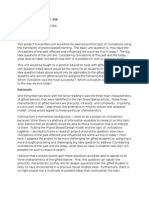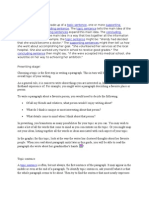0 ratings0% found this document useful (0 votes)
5 viewsEnglish Lectures
English Lectures
Uploaded by
Rana SaqlainLectures English
Copyright:
© All Rights Reserved
Available Formats
Download as PPTX, PDF, TXT or read online from Scribd
English Lectures
English Lectures
Uploaded by
Rana Saqlain0 ratings0% found this document useful (0 votes)
5 views12 pagesLectures English
Original Title
English lectures
Copyright
© © All Rights Reserved
Available Formats
PPTX, PDF, TXT or read online from Scribd
Share this document
Did you find this document useful?
Is this content inappropriate?
Lectures English
Copyright:
© All Rights Reserved
Available Formats
Download as PPTX, PDF, TXT or read online from Scribd
Download as pptx, pdf, or txt
0 ratings0% found this document useful (0 votes)
5 views12 pagesEnglish Lectures
English Lectures
Uploaded by
Rana SaqlainLectures English
Copyright:
© All Rights Reserved
Available Formats
Download as PPTX, PDF, TXT or read online from Scribd
Download as pptx, pdf, or txt
You are on page 1of 12
CODE SWITCHING AND CODE
MIXING
Miss Ayesha Ghulam Rasool
CODE SWITCHING
• Code switching is the practice of unpredictably changing one’s
language, dialect or speaking style to better fit one’s environment.
• Also a universal language-contact phenomenon that reflects the
grammars of both languages working simultaneously.
• Code switching is possible in bilingual or multilingual environment but
not in monolingual.
• WHAT IS CODE SWITCHING?
CONTINUE…
• Code switching occurs when a speaker alternates between two or
more languages, or language varieties, in the context of a single
conversation.
• Multilinguals, speakers of more than one language, sometimes use
elements of multiple languages when conversing with each other.
• Also Style, Register and Voice, whether in spoken or written language,
can then be included in a broad definition of code-switching
TYPES OF CODE SWITCHING
• There are two types of code switching:
• Inter-sentential:
• Inter-sentential code-switching, or Level A, is where individuals alternate
between languages while being answered in a different language.
• Example: Person 1: Where are you going? Person 2: Main ghar ja rha hon.
• Intra-sentential:
• Level B is called “Intra sentential code-switching," where the speaker uses two
or more languages in one speech.
• Example: Main Noise sy irritate ho rhi hon, hmain kuch action lena pary ga.
L A N GUA G E /D IA LE C T C O D E - S W IT C H IN G
S T YLE C O D E - S W IT C H IN G
• REASON FOR CODE SWITCHING
• No similar words in English
• Did not know the English word
• To fill the gap in speaking
• Easier to speak in own language
• To avoid misunderstanding
• Other reasons
CODE MIXING
• WHAT IS CODE MIXING
• Code mixing is possible in bilingual or multilingual environments.
• Is also a language contact phenomenon that doesn't reflect the
grammars of both languages working simultaneously.
• Words are borrowed from one language and adapt it in other language
and it is usually without a change of topic.
• It often occurs within one sentence, one element is spoken in language
A and the rest in language B.
• This term is usually found in mainly in informal interaction.
REASON FOR CODE-MIXING
• REASONS FOR CODE MIXING
• Interjection
• Quoting somebody else
• Expressing group identity
• Talking about a particular topic
• Repetition used for clarification
• To soften or strengthen request or command
DIFFERENCE BETWEEN CODE-
SWITCHING AND CODE-MIXING
CODE-SWITCHING CODE-MIXING
• Code switching is nothing but • Code mixing is mixing of mostly
switching from one language to other linguistic elements, or `words, from
to create the special effect. one language to other or mixed
• Example: 'They reached there on together.
time lakin (but) the cake order wasn't • Example: Main kal university jaa
ready. ' rahi thi and raaste me I met Sudha.
Translation (I was going for a movie
yesterday and on the way, I met
Sudha). Simply, Code mixing is
mixing of two or more languages
while communicating.
You might also like
- Human Error Root Cause Analisys - HercaDocument6 pagesHuman Error Root Cause Analisys - HercaSamuel Colaço100% (4)
- 2 - AshbyFarrall - Then Brain BasisF2Document12 pages2 - AshbyFarrall - Then Brain BasisF2Sharen DhaliwalNo ratings yet
- Relationship Between Language and CommunicationDocument4 pagesRelationship Between Language and CommunicationEwata Thompson90% (10)
- Assignment2 American FOOD LESSON PLANDocument3 pagesAssignment2 American FOOD LESSON PLANShade PetersNo ratings yet
- Prince Taxonomy Given New InformationDocument23 pagesPrince Taxonomy Given New InformationmaubiniNo ratings yet
- Code SwitchingDocument12 pagesCode SwitchingDian RahayuningsihNo ratings yet
- Code Switching & MixingDocument2 pagesCode Switching & MixingMonjur ArifNo ratings yet
- Participants - Marwa Ikram, Misbah Khalid, Maryam JohnsonDocument21 pagesParticipants - Marwa Ikram, Misbah Khalid, Maryam JohnsonMah-e -NahmaNo ratings yet
- Code SwitchingDocument11 pagesCode SwitchingrinbarcellanoNo ratings yet
- Code MIXING AND CODE SWITCHINGDocument24 pagesCode MIXING AND CODE SWITCHINGHana Nur FitrahNo ratings yet
- Language Contact and Its OutcomesDocument33 pagesLanguage Contact and Its OutcomesWinterMae BacalsoNo ratings yet
- Mission Possible. Handout 2&3Document101 pagesMission Possible. Handout 2&3re.designer.maNo ratings yet
- Presentation Code SwiticingDocument22 pagesPresentation Code SwiticingAD BhuttoNo ratings yet
- Language Choice in Multilingual CommunitiesDocument11 pagesLanguage Choice in Multilingual CommunitiesMiftahul JannahNo ratings yet
- Multilingualism and Code-Switching in EducationDocument16 pagesMultilingualism and Code-Switching in EducationChlorida MetanaNo ratings yet
- Code SwitchingDocument16 pagesCode SwitchingAmy Cacho0% (1)
- Code Switching and Code MixingDocument25 pagesCode Switching and Code MixingIfah AaifahNo ratings yet
- Code Switching and Code MixingDocument25 pagesCode Switching and Code Mixinganna39No ratings yet
- Code SwitchingDocument4 pagesCode SwitchingFariz ArdiansyachNo ratings yet
- Linguistics Diglossia Baraa KareemDocument9 pagesLinguistics Diglossia Baraa KareemBaraa HassanNo ratings yet
- Code Switching and Code MixingDocument2 pagesCode Switching and Code MixingAtif HaiderNo ratings yet
- Techniques and Strategies For English Arabic TranslationDocument7 pagesTechniques and Strategies For English Arabic TranslationEngy ObadNo ratings yet
- Bilingual Is MDocument3 pagesBilingual Is MJaroos MohamedNo ratings yet
- Language Contact and Code-SwitchingDocument9 pagesLanguage Contact and Code-SwitchingAgus KaiserNo ratings yet
- Linguistics Interference: Code Switching and Code MixingDocument9 pagesLinguistics Interference: Code Switching and Code MixingSiti Ratna LuxviasihNo ratings yet
- Code SwitchingDocument1 pageCode SwitchingGuenevere EsguerraNo ratings yet
- Mixture of Varieties: Karbala UniversityDocument20 pagesMixture of Varieties: Karbala Universityنوفل السعديNo ratings yet
- Social Motivation For Code Switching in Sujatha Novels in TamilDocument4 pagesSocial Motivation For Code Switching in Sujatha Novels in TamilEditor IJTSRDNo ratings yet
- Reasons Speakers Use Code SwitchingDocument3 pagesReasons Speakers Use Code SwitchingJawad KhalidNo ratings yet
- Code Switching: A Variation in Language UseDocument7 pagesCode Switching: A Variation in Language UseBusari MusiliuNo ratings yet
- 3Lecture three معدل copyDocument25 pages3Lecture three معدل copyشهد راشدNo ratings yet
- Code Switching and Code Mixing Group 1Document17 pagesCode Switching and Code Mixing Group 1Tetap riangNo ratings yet
- (185300100) - Rofilah Qurrotu'Aini S. 2018 A. 7. Language Choiche. SociolinguisticsDocument2 pages(185300100) - Rofilah Qurrotu'Aini S. 2018 A. 7. Language Choiche. SociolinguisticsROFILAHSALSABILANo ratings yet
- Language Contact SituationsDocument30 pagesLanguage Contact SituationsEASSANo ratings yet
- BismillahDocument12 pagesBismillahRivalMaulanaNo ratings yet
- Code SwitchingDocument13 pagesCode SwitchingAileen Marie Franco Pon-an100% (1)
- Language in Society: Lady Lou C. Pido, MaltDocument39 pagesLanguage in Society: Lady Lou C. Pido, MaltKinderella PidoNo ratings yet
- CodeDocument20 pagesCodeayu suhestiNo ratings yet
- The Analysis of Code Mixing in Short StoryDocument13 pagesThe Analysis of Code Mixing in Short StoryDharWin d'Wing-Wing d'AriestBoyz100% (1)
- CODE-SWITCHING BORROWING Dr. CHOUIT S5 G4Document3 pagesCODE-SWITCHING BORROWING Dr. CHOUIT S5 G4Ilias JA IDNo ratings yet
- Codes: Group 4 Wice Marsella Muhammad Rafiq Tanjung Vika Nur RohmaDocument9 pagesCodes: Group 4 Wice Marsella Muhammad Rafiq Tanjung Vika Nur RohmaMuhammad Rafiq TanjungNo ratings yet
- Group 1 - Language Choice in Multilingual CommunitiesDocument34 pagesGroup 1 - Language Choice in Multilingual CommunitiesJesimiel PorwelosNo ratings yet
- D - 092 - Ni Made Ayu Sri Undari Dewi - Summary Week 3Document3 pagesD - 092 - Ni Made Ayu Sri Undari Dewi - Summary Week 3Ayu UndariNo ratings yet
- Code Switching and Code MixingDocument12 pagesCode Switching and Code Mixingnidal13346No ratings yet
- Module 2Document8 pagesModule 2Gilbert Caton BinasNo ratings yet
- Code Mixing and Code Switching SocioDocument2 pagesCode Mixing and Code Switching SocioBilqis Bilqis24No ratings yet
- Code SwitcingDocument15 pagesCode SwitcingIfah AaifahNo ratings yet
- Week 7 Code MixingDocument5 pagesWeek 7 Code MixingkurussNo ratings yet
- Code switching, Code mixing, and BORROWINGDocument4 pagesCode switching, Code mixing, and BORROWINGiqrabatool1684No ratings yet
- Code Switching: - Where Have You Been? Kami Sudah Menunggumu!Document3 pagesCode Switching: - Where Have You Been? Kami Sudah Menunggumu!Swarthana PutraNo ratings yet
- Code-Mixing Refers To The Mixing of Two or More Languages orDocument4 pagesCode-Mixing Refers To The Mixing of Two or More Languages orDoreen TingNo ratings yet
- Languages in Contact IKADocument4 pagesLanguages in Contact IKAChandra DewiNo ratings yet
- A Study of Reasons For Codeswitching in Pakistani Context: Literature ReviewDocument10 pagesA Study of Reasons For Codeswitching in Pakistani Context: Literature ReviewwaseemNo ratings yet
- Code-Switching - Metaphprical-Switching - Lexical BorrowingDocument20 pagesCode-Switching - Metaphprical-Switching - Lexical BorrowingSrusht OmerNo ratings yet
- Review of The Related LiteratureDocument6 pagesReview of The Related LiteratureKris Gia EscuetaNo ratings yet
- Code SwitchingDocument5 pagesCode SwitchingAriska Yuli0% (1)
- What Is Code-Switching? Language AlternationDocument35 pagesWhat Is Code-Switching? Language AlternationCao hảiNo ratings yet
- Code Switching and Code Mixing On China RichDocument25 pagesCode Switching and Code Mixing On China RichxxxxNo ratings yet
- Code SwitchingDocument15 pagesCode SwitchingyohanaNo ratings yet
- Tsabithaazra Quiz SociolinguisticsDocument3 pagesTsabithaazra Quiz SociolinguisticsBima BahariNo ratings yet
- Chapter 2 Code Switching MixingDocument27 pagesChapter 2 Code Switching MixingSii Tiudd Bala Bala100% (1)
- ENG 4120 - Unit2Document19 pagesENG 4120 - Unit2fanrNo ratings yet
- LM 7 El103Document8 pagesLM 7 El103Toytoy FamilyNo ratings yet
- Samantha Epp - Epse 408 - Assignment 1Document5 pagesSamantha Epp - Epse 408 - Assignment 1api-282582619No ratings yet
- Naeyc Standard 6Document3 pagesNaeyc Standard 6api-314699890No ratings yet
- Week 1Document967 pagesWeek 1Nurul Afiqah Awang100% (1)
- Attachemnet and IncestDocument17 pagesAttachemnet and IncestJusna KhanomNo ratings yet
- Action Plan - AbakadaDocument2 pagesAction Plan - AbakadaChyla BiscochoNo ratings yet
- Lesson Plan For Grade 9 Science Quarter 1 Week 2Document3 pagesLesson Plan For Grade 9 Science Quarter 1 Week 2Windie M. BemidaNo ratings yet
- Instant Ebooks Textbook Public Speaking Strategies For Success 8th Edition David Zarefsky Download All ChaptersDocument53 pagesInstant Ebooks Textbook Public Speaking Strategies For Success 8th Edition David Zarefsky Download All Chaptersaberinomwena100% (1)
- The Mind in Homeopathy: Rhetoric vs. RealityDocument6 pagesThe Mind in Homeopathy: Rhetoric vs. RealitySaurav AroraNo ratings yet
- Review of Psychiatry (Praveen Tripathi) - 1st Ed. (2016) PDFDocument142 pagesReview of Psychiatry (Praveen Tripathi) - 1st Ed. (2016) PDFinchara jagadeesh100% (2)
- Roy Goodwin D'AndradeDocument2 pagesRoy Goodwin D'AndradeburnnotetestNo ratings yet
- Ded553 Tiana Whitakeassessment Plan DraftDocument9 pagesDed553 Tiana Whitakeassessment Plan Draftapi-620563287No ratings yet
- What Is A ParagraphDocument11 pagesWhat Is A ParagraphStevano Richard DesmondNo ratings yet
- De Thi Hoc Ki 1 Anh 8 de 1Document6 pagesDe Thi Hoc Ki 1 Anh 8 de 1Minh NguyễnNo ratings yet
- What Is Chatgpt? (And How To Use It)Document5 pagesWhat Is Chatgpt? (And How To Use It)guruict2021No ratings yet
- Questionnaire EDITEDDocument6 pagesQuestionnaire EDITEDJane Bunuan SaludaresNo ratings yet
- 1.5 Workplace Protocol and InteractionDocument4 pages1.5 Workplace Protocol and InteractionFernando JoseNo ratings yet
- VectraDocument6 pagesVectraalmaghairehkhaledNo ratings yet
- Cartography As An Art and A Science?: Cartographic Journal The June 1995Document22 pagesCartography As An Art and A Science?: Cartographic Journal The June 1995Malena MastricchioNo ratings yet
- Learning Deep Features For Discriminative Localization - SuppDocument9 pagesLearning Deep Features For Discriminative Localization - SuppgousesyedNo ratings yet
- Outline of Stratificational Grammar-07-Lamb-Sydney LambDocument115 pagesOutline of Stratificational Grammar-07-Lamb-Sydney LambjoannaNo ratings yet
- Daily Lesson Log (DLL)Document3 pagesDaily Lesson Log (DLL)Gomonan Rosanna100% (3)
- Formation of Ecological Communication Skills of Primary School StudentsDocument3 pagesFormation of Ecological Communication Skills of Primary School StudentsEditor IJTSRDNo ratings yet
- Fpsyt 11 00323Document23 pagesFpsyt 11 00323Radinovic MarijanaNo ratings yet
- Module 7 Assessment in ArtDocument4 pagesModule 7 Assessment in ArtJamaica Lyra AndradeNo ratings yet
- Most Dangerous Game Unit 2008Document25 pagesMost Dangerous Game Unit 2008ThiriNo ratings yet

























































































